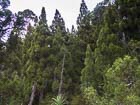
Closed-canopy stand of mature trees in habitat just N of Lake Dobson, Mt. Field National Park [C. J. Earle, 2015.02.26].
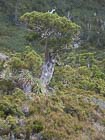
Old tree by a tarn on the Shelf Tarns track, Mt. Field National Park [C. J. Earle, 2015.02.27].
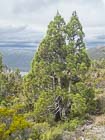
Tree, about 5 m tall, in alpine heath on the Shelf Tarns track, Mt. Field National Park [C. J. Earle, 2015.02.27].
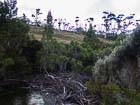
Riparian forest of A. cupressoides near car park at Lake Dobson, Mt. Field National Park. Matrix forest in background is dominated by snow gum, Eucalyptus coccifera [C. J. Earle, 2015.02.26].
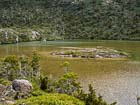
High subalpine tarn surrounded by an old forest dominated by A. cupressoides; Shelf Tarns track, Mt. Field National Park [C. J. Earle, 2015.02.27].

Bark on a mature tree, Cradle Mtn. National Park [©Rick Fencl, 2017.12.03].
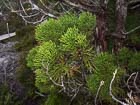
Foliage showing typical foliar units, sapling, near Lake Dobson, Mt. Field National Park [C. J. Earle, 2015.02.26].
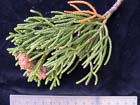
Foliar unit bearing recently mature seed cones [C. J. Earle, 2015.03.01].
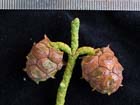
Twig bearing recently mature seed cones [C. J. Earle, 2015.03.01].
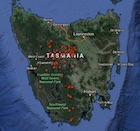
Distribution of A. cupressoides; map generated by the Australia Virtual Herbarium.

Former subalpine parkland of A. cupressoides, ravaged by wildfire and now regenerating from seed; Shelf Tarns track, Mt. Field National Park [C. J. Earle, 2015.02.27].
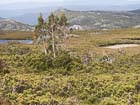
Small clump of krummholz A. cupressoides, Cradle Mountain National Park [C. J. Earle, 2015.03.03].

Large (ca. 30 cm tall) seedling of A. cupressoides; near Lake Dobson, Mt. Field National Park [C. J. Earle, 2015.02.26].

Conservation Status

Athrotaxis cupressoides
D. Don 1838
Common names
Pencil pine.
Taxonomic notes
No synonyms. Type locale is simply "Van Diemen's Land" (Tasmania), as collected by Ronald Campbell Gunn (1808-1881), pioneering Tasmanian botanist. Gunn was a busy fellow in 1838, finding time for a visit to Flinders Island with Sir John Franklin (who had founded the Tasmanian Society for the Study of Natural Science during the previous year) while holding down a job as assistant police superintendent in Hobart, so it is difficult to say where this specimen was likely to have been collected; but in 1840 in the company of Joseph Dalton Hooker, both Gunn and Hooker collected it on the Pine River in the Central Highlands. At the time, this would have been the easiest place to find the species; with the exception of Mt. Field, another plausible type locality, the rest of the species' range appears as white space on an 1837 map of Tasmania. It may be that since the visiting Hooker was the son of W. J. Hooker, one of the most prominent botanists of the day, Gunn was likely taking Hooker on a tour of Tasmanian botany and would have wanted to show him this, one of Gunn's more notable discoveries (inference based on Gunn's biography by Burns and Skemp [1966], and on collection records HO2846 and HO2849 at the Australia Virtual Herbarium).
Description
Trees to 20 m tall and 100 cm dbh, single or multi-stemmed, with a conical crown that becomes irregular with age; may also form a krummholz or layer or sucker to form a multistemmed clone. Bark light brown, flaky, fibrous, becoming furrowed with age, exfoliating in long thin strips. Foliage branchlets numerous, mostly alternate, spreading, forming roughly globose foliar units 20-40 cm diameter. Leaves helically arranged on twigs in 5 ranks, on terminal twigs 3-6 × 2-3 mm, fused at base, decurrent, imbricate, appressed, the visible part keeled, rhombic-oblong; margins thin hyaline, apex obtuse; usually with widely spaced stomata in two faint bands. Pollen cones terminal, solitary, othe base surrounded by shortened leaves 3-5 mm long, yellowish turning brown, comprised of 10-15 helically arranged broad-triangular microsporophylls. Seed cones terminal, solitary, globose, 10-16 mm diameter, pale green turning brown, each composed of 10-15 helically arranged scales; opening slightly upon maturity, typically retained on the tree for about one additional year. Scales woody at maturity, each with a centrally-depressed apex bearing a recurved, acute bract tip; lower surface rough and wrinkled, upper surface striated. Seeds 20-30 per cone, obovate, 1.5-2 mm long with 2 wings each ca. 1 mm wide (Farjon 2010 and field observations, 2015). Cotyledons 2, germination epigeal" (Silba 1986).
Distribution and Ecology
Australia: W. Tasmania, montane to subalpine (700-1,300 m elevation) on peaty or wet-rocky soils, commonly with Sphagnum cristatum, Gleichenia alpina, Leucopogon hookeri, Restio australis, Gymnoschoenus sphaerocephalus, Orites acicularis, Richea scoparia, Richea pandanifolia, Nothofagus gunnii, Astelia alpina, Diselma archeri, Pherosphaera hookeriana, Athrotaxis selaginoides, and Eucalyptus coccifera; at lower altitudes, often with Nothofagus cunninghamii and Phyllocladus aspleniifolius (Farjon 2010). The species is primarily associated with the Athrotaxis cupressoides open woodland, Athrotaxis cupressoides-Nothofagus gunnii short rainforest, and Athrotaxis cupressoides rainforest vegetation communities; it is also a component of the eastern alpine sedgeland, Athrotaxis selaginoides subalpine scrub, subalpine Leptospermum nitidum woodland, Athrotaxis selaginoides-Nothofagus gunnii short rainforest, Athrotaxis selaginoides rainforest, and Nothofagus gunnii rainforest and scrub vegetation communities (Kitchener and Harris 2013). Hardy to Zone 8 (cold hardiness limit between -12.1°C and -6.7°C) (Bannister and Neuner 2001).
A. cupressoides regenerates from seed, and also vegetatively, through root suckers; this is most commonly seen in dense forest stands and in bogs. Exclosure experiments and field observations show that seedlings, suckers and adult foliage are heavily grazed by introduced placental and native marsupial mammals (Cullen and Kirkpatrick 1988). Native populations are also showing signs of a dieback likely caused by an introduced strain of Phytophthora (Farjon 2010).
"At the upper limit of tree growth in western Tasmania, often above the regional Eucalyptus timberline, are scattered stands of the endemic pencil pine. The stands occur beside tarns and on the damp shady backwalls of cirques, where the ice lingered in the waning phases of the last glacial period, and snow accumulates each winter. The regional hazard, fire, rarely penetrates these cool rainy heights and some of the trees are over a thousand years old... The old trees carry poor cone crops, seedlings are almost absent, and the distribution and structure of the populations suggest that regeneration is rare and periodic... I envisage pencil pine as a species expanding its range during the cold variable climate of Pleistocene Tasmania and currently 'sitting out' the Holocene in scattered stands above timberline. Such stands have been present throughout their current range on Mount Field for the last thousand years, but the altitudinal locus of regeneration appears to have shifted. Gradual migrations have occurred and local 'even-aged' stands developed. Great longevity allows the species to track environmental variability on a scale of centuries, regenerating mainly in those periods when favourable combinations of circumstances permit" (Ogden 1985).
The principal themes of Ogden's (1985) assessment have lately been reiterated with a new spin featuring climate change and more data-rich analyses. In 1960–1961, human-ignited wildfires during an extremely dry summer caused the loss of approximately ca. 10% of the geographic extent of A. cupressoides, with little regeneration in the aftermath. Work by Holz et al. (2014) has found that fire frequency did not vary following the arrival of European settlers, and that A. cupressoides populations were able to persist under a regime of low-to-mid severity fires prior to the 1960 fires. However, the 1960 fires were of greater severity than previous fires, and the consequent loss of A. cupressoides has been largely irreversible due to high fuel loading in postfire vegetation communities that are dominated by resprouting shrubs; thus, a fundamental transition to a more fire-prone community. Holz et al. (2014) suggest that the feedback between regeneration failure and increased flammability will be further exacerbated by a warmer and drier climate, restricting A. cupressoides to only the most fireproof environments. This prediction was validated in 2015-2016, which produced the driest year on record (about 80% of the previous minimum in 1960-1961), along with a spate of wildfires that were highly destructive of A. cupressoides, although less so than the 1960-1961 fires (Turner 2016).
This species forms the habitat of the pencil pine moth, Dirce aesiodora, the larvae of which feed only upon A. cupressoides foliage (and which closely resemble A. cupressoides twigs).
Remarkable Specimens
The oldest known specimen is documented in a tree-ring chronology covering the period 1028-1975 (crossdated after 1053), collected in Mt. Field National Park by V. C. Lamarche, J. G. Ogden, and P. W. Dunwiddie (doi.org/10.25921/sdz0-jb24). The oldest tree in the study, which was alive, provided a 946-year record; another 8 trees at the site proved to be more than 700 years old. The site is described as being at 1200 m elevation, steep, and east-facing with coarse, rocky soils derived from dolerite, which is very similar to basalt as far as soil properties are concerned (Campbell 1982).
Ethnobotany
Due to its high-elevation habitat and remote growth, it has always had negligible usage, and any use by aboriginal peoples is unrecorded. It is occasionally seen in craftwood, and occasionally (or rarely) in horticulture.
The species has proven useful in dendrochronological research. A recent but brief review was presented by Allen et al. (2011), as part of an interesting dendroclimatic study. Use of the species had earlier been reviewed by Ogden (1978, 1985), Norton and Palmer (1992), and Palmer and Ogden (1992).
Observations
This species is uncommon even in botanical gardens and arboreta. It can be readily seen at the principal National Parks within its range, of which the most accessible and probably the most remarkable is Cradle Mountain National Park. The hike up Cradle Mountain will show you alpine settings of A. cupressoides and local individuals of A. x laxifolia. I also recommend a visit to Mount Field National Park, where the Shelf Tarns walk is one of the best places to see very old specimens of A. cupressoides, including a facinating old forest with many krummholz trees and evidence of major fires. The walk will also turn up occasional A. x laxifolia in various places.
Exceptionally large trees are reported to occur at Lake Ball/Dixon's Kingdom, Walls of Jerusalem National Park (M. de Salas, iNaturalist, 2019.05.08).
Remarks
Citations
Allen, K. J., J. Ogden, B. M. Buckley, E. R. Cook, and P. J. Baker. 2011. The potential to reconstruct broadscale climate indices associated with southeast Australian droughts from Athrotaxis species, Tasmania. Climate Dynamics, DOI 10.1007/s00382-011-1011-7.
Burns, T. E. and J. R. Skemp. 1966. Gunn, Ronald Campbell (1808–1881). Originally published in the Australian Dictionary of Biography, Volume 1, now online, accessed 2016.02.23.
Campbell, D. A. 1982. Preliminary estimates of summer streamflow for Tasmania. Pp. 170-177 in Climate from Tree Rings (M. K. Hughes et al., eds.). Cambridge University Press.
Cullen, P. J. and J. B. Kirkpatrick. 1988. The ecology of Athrotaxis D. Don (Taxodiaceae). I. Stand structure and regeneration of A. cupressoides. Australian Journal of Botany 36(5):547-560.
Donn, David. 1838. Annals of Natural History 1:235. Available at Archive.org, accessed 2016.02.23.
Holz, A., S. W. Wood, T. T. Veblen and D. M. J. S. Bowman. 2014. Effects of high-severity fire drove the population collapse of the subalpine Tasmanian endemic conifer Athrotaxis cupressoides. Global Change Biology, doi: 10.1111/gcb.12674.
Kitchener, Anne, and Stephen Harris (eds.). 2013. From forest to Fjaeldmark: descriptions of Tasmania's vegetation. 2013. http://dpipwe.tas.gov.au/conservation/flora-of-tasmania/from-forest-to-fjaedlmark-descriptions-of-tasmanias-vegetation-(edition-2), accessed 2016.02.26, now defunct.
Turner, P. 2016.04.07. The majestic Pencil Pine: pushed to the brink. https://peptalkecology.wordpress.com/2016/04/07/the-majestic-pencil-pine-pushed-to-the-brink/, accessed 2017.12.29, now defunct.
See also
Elwes and Henry 1906-1913 at the Biodiversity Heritage Library. This series of volumes, privately printed, provides some of the most engaging descriptions of conifers ever published. Although they only treat species cultivated in the U.K. and Ireland, and the taxonomy is a bit dated, still these accounts are thorough, treating such topics as species description, range, varieties, exceptionally old or tall specimens, remarkable trees, and cultivation. Despite being over a century old, they are generally accurate, and are illustrated with some remarkable photographs and lithographs.
Farjon 2005.
Native Conifers of Tasmania, a short but interesting and well illustrated site maintained by the Department of Environment and Land Management, Parks and Wildlife Service, Tasmania. http://www.parks.tas.gov.au/veg/pines.html, accessed 1999.08.11, now defunct.
Threatened Conifers of the World.













